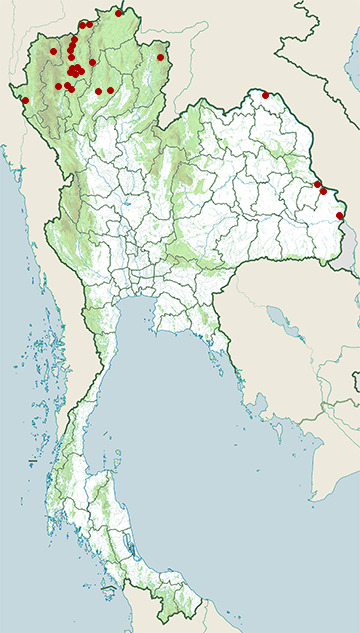Species of Thailand
Wire-tailed swallow
Hirundo smithii
William Elford Leach, 1818
In Thai: นกนางแอ่นหางลวด
The wire-tailed swallow (Hirundo smithii) is a small passerine bird in the swallow family. It has two subspecies: H. s. smithii, which occurs throughout Africa, and H. s. filifera, which is found in southern and southeastern Asia. It is mainly resident, but populations in Pakistan and northern India migrate further south in winter. The genus name Hirundo is the Latin word for swallow. The species name smithii commemorates Christen Smith, a Norwegian botanist and geologist.
Description
The wire-tailed swallow is a small swallow, measuring 18 cm in length. It has bright blue upperparts, bright white underparts and a chestnut cap. Immature birds lack tail wires, and have dull brown (rather than chestnut) caps. The species is named for the very long filamentous outermost tail feathers, which trail behind like two wires. The sexes are similar in appearance, but the female has shorter "wires". Juveniles have a brown crown, back and tail. The Asian form, H. s. filifera, is larger and longer-tailed than the abundant African H. s. smithii.
Habits
This bird is found in open country near water and human habitation. Wire-tailed swallows are fast flyers and they generally feed on insects, especially flies, while airborne. They are typically seen low over water, with which they are more closely associated than most swallows.
Nesting
The neat half-bowl nests are lined with mud collected in the swallows' beaks. They are placed on vertical surfaces near water under cliff ledges or nowadays more commonly on man-made structures such as buildings and bridges. The clutch is three to four eggs in Africa, up to five in Asia (Turner and Rose). These birds are solitary and territorial nesters, unlike many swallows, which tend to be colonial.
Taxonomy and systematics
The wire-tailed swallow is a member of the genus Hirundo, a group of "barn swallows". It has two subspecies:
- H. s. smithii was first described by William Elford Leach and K. D. Koenig in 1818. Known as the African wire-tailed swallow, it is found throughout Africa.
- H. s. filifera was first described by Stephens in 1826. Also known as the Asian wire-tailed swallow, it is found in southern and southeastern Asia.
This article uses material from Wikipedia released under the Creative Commons Attribution-Share-Alike Licence 3.0. Eventual photos shown in this page may or may not be from Wikipedia, please see the license details for photos in photo by-lines.
Category / Seasonal Status
BCST Category: Recorded in an apparently wild state within the last 50 years
BCST Seasonal status: Resident or presumed resident
Scientific classification
- Kingdom
- Animalia
- Phylum
- Chordata
- Class
- Aves
- Order
- Passeriformes
- Family
- Hirundinidae
- Genus
- Hirundo
- Species
- Hirundo smithii
Common names
- Thai: นกนางแอ่นหางลวด
Conservation status

Least Concern (IUCN3.1)

Near Threatened (ONEP)
Photos
Please help us review the bird photos if wrong ones are used. We can be reached via our contact us page.
Range Map

- Chanuman District, Amnat Charoen
- Chiang Dao District, Chiang Mai
- Chiang Dao Wildlife Sanctuary
- Doi Inthanon National Park
- Doi Lo District, Chiang Mai
- Doi Pha Hom Pok National Park
- Doi Phu Kha National Park
- Doi Saket District, Chiang Mai
- Doi Suthep - Pui National Park
- Khemarat District, Ubon Ratchathani
- Khun Chae National Park
- Kut Thing Non-Hunting Area
- Mae Ai District, Chiang Mai
- Mae Mo District, Lampang
- Mae Rim District, Chiang Mai
- Mae Taeng District, Chiang Mai
- Mueang Chiang Mai District, Chiang Mai
- Mueang Lampang District, Lampang
- Nong Bong Khai Non-Hunting Area
- Pa Sang District, Lamphun
- Pai District, Mae Hong Son
- Pha Daeng National Park
- Pha Taem National Park
- Salawin National Park
- San Sai District, Chiang Mai



